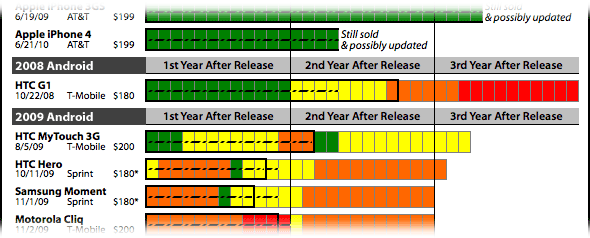Michael Degusta has a wonderful blog post up about the history of missing software updates for Android smartphones, compared to Apple’s iPhone. A sample:
In this chart, green blocks represent periods when a phone ran the most up-to-date major version of its operating system, while yellow, orange, and red blocks represent periods where a phone could only run increasingly out-of-date major versions. See Michael’s post for the full chart and some great analysis.
Two factors combine to make the lack of updates a significant problem. First, in the United States at least, most phones are sold on two-year contracts, so a lack of updates means they will almost certainly be used well after their OS is no longer the current version. Second, since smartphones are constantly connected to the cell-phone network and the Internet, they present an attractive and vulnerable target for malware authors when security vulnerabilities are discovered. If updates can’t be applied to many of the smartphones in use, then the potential harm from a security problem expands greatly. Indeed, the many Android privacy and security problems show the potential severity of the issue.
So what is to be done? It’s understandable why, in the fast-moving and competitive market for Andoid smartphones, makers don’t want to spend money supporting devices they’re no longer selling. Yet if two-year contracts are the standard, it may not be unreasonable for users to expect makers to support a device for at least two years after they stop selling it. With the FTC’s recent reemphasis on trade practices that are “unfair” but not necessarily “deceptive” (a subject worthy of a post of its own), it will be interesting to see if the agency has anything to say about the Android orphan problem.
